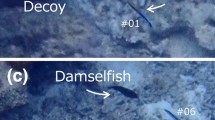Summary
The post-hatching growth and sleeping group sizes of green iguanas (Iguana iguana) were followed on Barro Colorado Island, Panama, for 3 successive years. The laboratory clearing was subdivided and surveyed routinely for iguanas, most intensively the six weeks following onset of hatching. A similar pattern of influx of iguanas into the clearing took place each May. Over the early weeks the size of groups generally increased. Animals sleeping in larger groups had significantly faster growth rates. Animals that disappeared from the clearing prior to July had larger group sizes prior to disappearance than those that remained. Growth rates measured in animals that remained declined markedly after June. Possible reasons for the social grouping of young iguanas are discussed.
Similar content being viewed by others
References
Bertram BCR (1979) Living in groups: predators and prey. In: Krebs J, Davies N (eds) Behavioural ecology. Sinauer, Sunderland, MA, pp 64–96
Bock BB (1984) Movement patterns relative to nesting site locations in a population of green iguanas (Iguana iguana) in Panama. Unpublished PhD dissertation, University of Tennessee, Knoxville
Burghardt GM, Rand AS, Greene HW (1977) Social behavior in hatchling green iguanas: life at a reptile rookery. Science 195:689–691
Drummond H, Burghardt GM (1982) Orientation in dispersing hatchling green iguanas, Iguana iguana. In: Burghardt GM, Rand AS (eds) Iguanas of the world: their behavior, ecology, and conservation. Noyes, Park Ridge, NJ, pp 271–291
Drummond H, Burghardt GM (1983) Nocturnal and diurnal nest emergence in green iguanas. J Herpetol 17:290–292
Greene HW, Burghardt GM, Dugan BA, Rand AS (1978) Predation and the defensive behavior of green iguanas (Reptilia, Lacertilia, Iguanidae). J Herpetol 12:169–176
Morse DH (1980) Behavioral mechanisms in ecology. Harvard, Cambridge, MA
Rand AS, Greene HW (1982) Latitude and climate in the phenology of reproduction in the green iguana, Iguana iguana. In: Burghardt GM, Rand AS (eds) Iguanas of the world: their behavior, ecology, and conservation. Noyes, Park Ridge, NJ, pp 142–149
Troyer K (1984) Behavioral acquisition of the hindgut fermentation system by hatchling Iguana iguana. Behav Ecol Sociobiol 14:189–193
Author information
Authors and Affiliations
Rights and permissions
About this article
Cite this article
Burghardt, G.M., Rand, A.S. Group size and growth rate in hatchling green iguanas (Iguana iguana). Behav Ecol Sociobiol 18, 101–104 (1985). https://doi.org/10.1007/BF00299038
Received:
Accepted:
Issue Date:
DOI: https://doi.org/10.1007/BF00299038




